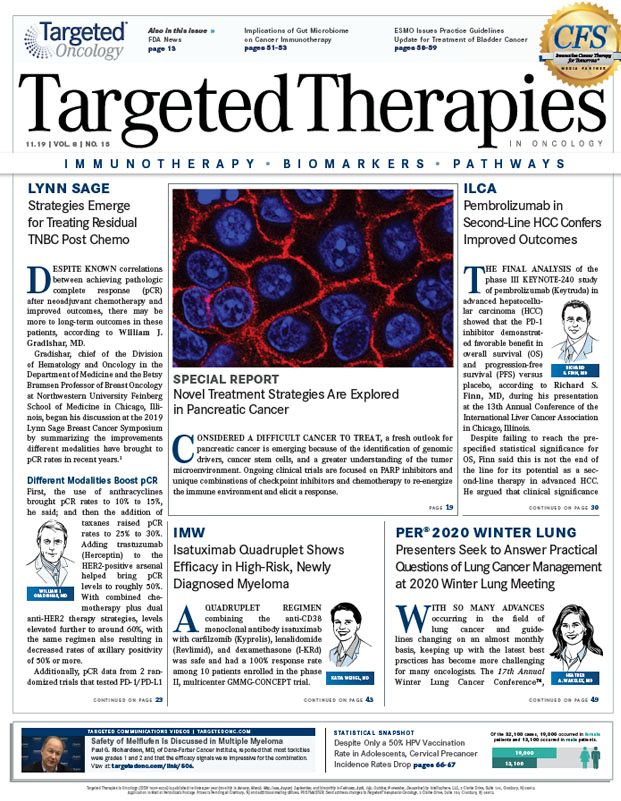PARP Inhibitors, Early-Stage Treatment Signal Shift in Focus for Patients With TNBC
An expanded treatment array that uses PARP inhibitors, antibody–drug conjugates, and inhibitors of the AKT and MEK pathways gives patients with triple-negative breast cancer reason for hope.
Hope S. Rugo, MD
An expanded treatment array that uses PARP inhibitors, antibodydrug conjugates (ADCs), and inhibitors of the AKT and MEK pathways gives patients with triple-negative breast cancer (TNBC) reason for hope.
However, in the face of these promising investigational therapies, the focus must turn to diagnosis and treatment earlier in the disease course, said Hope S. Rugo, MD, in a presentation during the 2019 Lynn Sage Breast Cancer Symposium.1
“Moving treatment to the early-stage setting is critical, because we clearly acquire mutations with treatment,” said Rugo, director of Breast Oncology and Clinical Trials Education at the University of California, San Francisco Helen Diller Family Comprehensive Cancer Center. “This results in less efficacy, and we may lose out on some great drugs based on doing our studies in the late-line setting.”
The current therapeutic landscape for early-stage TNBC includes optimal neoadjuvant therapy. “If we add platinum [treatment] to a taxane-/anthracycline-based regimen, we see higher pathologic complete response [pCR] rates overall, regardless of the study,” she said. “However, there is increased toxicity and some reduced delivery of taxane/anthracycline, so I only add platinum for patients who aren’t responding well or as an anthracycline-sparing agent. I will typically start with paclitaxel following cycle 4, if needed.”
Expanding PARP Inhibitors
“Because recent trials were not powered to assess event-free survival, we don’t yet know the impact on long-term outcomes of platinum-based chemotherapy combined with standard chemotherapy,” Rugo said. “The issue of platinum is going to become a much more acute decision-making issue as we get more trial results from BrighTNess and KEYNOTE-522.”PARP inhibitors have also been gaining momentum, with the approvals of both olaparib (Lynparza) and talazoparib (Talzenna). Olaparib is indicated for the treatment of patients with germline BRCA-positive, HER2-negative metastatic breast cancer who have previously received chemotherapy. Talazoparib is available for patients with deleterious or suspected deleterious germline BRCA-mutated, HER2-negative locally advanced or metastatic breast cancer.
In the registration trials for olaparib and talazoparib, OlympiAD and EMBRACA, respectively, Rugo said, “We’re seeing great responses in patients who don’t have platinum-resistant germline BRCA-associated breast cancers, but these responses are not as durable.”
In OlympiAD, olaparib was compared with standard chemotherapy in previously treated patients with BRCA-positive, HER2-negative breast cancer. Results showed the median progression-free survival (PFS) to be 7.0 months with olaparib and 4.2 months in the physician’s choice group (HR, 0.58; 95% CI, 0.43-0.80;P= .001).2
Earlier this year, final overall survival (OS) data from OlympiAD were published, showing no statistically significant improvement in OS with olaparib versus physician’s choice of chemotherapy, at 19.3 months and 17.1 months, respectively (HR, 0.90; 95% CI, 0.66-1.23;P= .513).3
In the EMBRACA trial, talazoparib was compared with chemotherapy in patients with BRCA-positive advanced breast cancer. The median PFS was 8.6 months in the talazoparib group compared with 5.6 months in the physician’s choice group.4Mature OS data are not yet available, Rugo said. “One question is whether or not carboplatin would be just as good as giving a PARP inhibitor, especially since most people tolerate them well compared with platinum.”
AntibodyDrug Conjugates
The next steps for PARP inhibitors in breast cancer include the neoadjuvant and adjuvant settings, in patients with other germline mutations with defects in DNA repair, and in those with somatic mutations, Rugo said.ADCs offer the hope of sensitive discrimination between cancer cells and healthy cells. ADCs combine highly selective monoclonal antibodies for a tumor-associated antigen with minimal expression on healthy cells, with a potent cytotoxic agent that can target cell death with internalization and release into the tumor cellas well as a stable linker, she said.
Only trastuzumab emtansine (T-DM1; Kadcyla) is approved for breast cancer in HER2-positive disease. Several ADCs are in development for TNBC, Rugo said.
For example, sacituzumab govitecan is a novel Trop-2directed ADC. “Trop-2 seems to be expressed on many different kinds of cancers,” she said. “The toxin is SN-38, the active metabolite of irinotecan, so it should be great for breast cancer.”
Updated results from a phase I/II trial of sacituzumab govitecan demonstrated an overall response rate of 33.3% (95% CI, 24.6%-43.1%). The median duration of response was 7.7 months (95% CI, 4.9-10.8).5
“These results were good, and there were no life-threatening toxicities,” Rugo said, noting that larger trials are also underway.
Other ADCs in development include ladiratuzumab vedotin, which targets the LIV-1 zinc transporter, as well as a microtubule-disrupting agent. U3-1402 is a novel anti-HER3 ADC currently being developed.
“HER3 is overexpressed in [some] ER-positive breast cancers and a modest number of TNBCs,” Rugo said. “U3-1402 is intriguing and has the potential to be efficacious in different subsets of breast cancer.”
References:
- Rugo H. New options for triple negative cancer. Presented at: Lynn Sage Breast Cancer Symposium; October 3-6, 2019; Chicago, IL.
- Robson ME, Im SA, Senkus E, et al. Olaparib for metastatic breast cancer in patients with a germline BRCA mutation. 2017;377(6):523-533.N Engl J Med. doi: 10.1056/NEJMoa1706450.
- Robson ME, Tung N, Conte P, et al. OlympiAD final overall survival and tolerability results: Olaparib versus chemotherapy treatment of physician’s choice in patients with a germline BRCA mutation and HER2-negative metastatic breast cancer.Ann Oncol. 2019;30(4):558-566. doi: 10.1093/annonc/mdz012.
- Litton JK, Rugo HS, Ettl J, et al. A phase 3 trial comparing talazoparib, an oral PARP inhibitor, to physician’s choice of therapy in patients with advanced breast cancer and a germline BRCA-mutation. Presented at: 2017 San Antonio Breast Cancer Symposium; December 5-9, 2017; San Antonio, TX. Abstract GS6-07. cancerres.aacrjournals.org/content/78/4_Supplement/GS6-07.
- Bardia A, Vahdat LT, Diamond J, et al. Sacituzumab govitecan (IMMU-132), an anti-Trop-2-SN-38 antibody-drug conjugate, as ≥3rd-line therapeutic option for patients with relapsed/refractory metastatic triple-negative breast cancer (mTNBC): efficacy results. Presented at: 2017 San Antonio Breast Cancer Symposium; San Antonio, Texas, December 5-9, 2017. Presentation GS1-07. immunomedics.com/wp-content/uploads/2017/12/SABCS-2017-Phase-2-Oral-Bardia.pdf.
